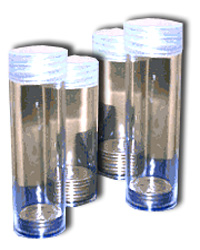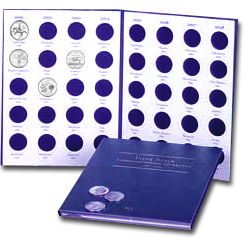- Keep them cool and dry. Sharp changes in temperature and moisture—as are natural in most attics and basements—promote tarnish and spots that devalue your coins.
- Use original holders. All modern proof sets and commemoratives should be bought and sold in their original cases and capsules.
- Save documentation. A Certificate of Authenticity and an information card that come with United States Mint proof, uncirculated, and commemorative sets. If these are missing, your coins will be harder to sell.
- Keep them safe. There’s no safety like a safe-deposit box at a bank. If you keep your collection at home, check that your home insurance covers it for the full replacement cost.
 Plastic Tubes
Plastic Tubes
 Foldout Albums
Foldout Albums
 2"x2" Cardboard Holders
2"x2" Cardboard Holders
 Coin Slab
Coin Slab
Storage Options
-
Flips have two pockets—one for a coin, the other for a label. Flips made of Mylar® and
the like are good but can be a little stiff and brittle. When inserting or removing a coin,
"bow" it by pressing opposite sides inward to avoid scratching the coin.
-
Soft plastic holders aren't always better. You definitely want to avoid those that contain polyvinyl
chloride (PVC), a chemical that softens plastics. PVC can eventually coat a valuable coin with a
sticky green slime, which eats into the coin’s surface and ruins it.
-
2"x2" cardboard holders.
-
Plastic tubes (ideal for rolls of coins).
-
Hard plastic holders (preferable for more valuable coins) are available for individual coins and small sets.
-
Polyethylene sleeves are good for short-term storage.
-
Paper envelopes are okay for circulating coins, if the envelopes are made for holding coins.
Other envelopes could contain chemicals that cause your coins to change color over time.
-
Foldout albums can protect coins from wear and handling, but not from air-borne chemicals that cause toning.
These albums are not a good choice for long-term storage of higher-grade coins.
-
Slabs (sonically sealed hard plastic holders for individual coins)
offer good protection, but slabbing is an expensive process, so it's best to use it for more valuable coins.
|



